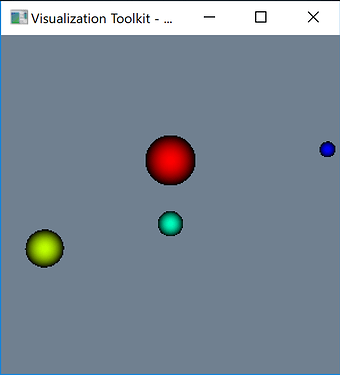Hello,
I’m new with vtk, I would like to read a vtk file that contains coordinates and radii of spheres.
In paraview, I am able to read it and make the data to be represented with Point Gaussian with the correct radius (Use Scalar Array, Gaussian Radius = 1).
I want to do the same with vtk and Python if possible.
I guess I should use vtkUnstructuredGridReader() to read the file but I don’t know how to manage the data then.
Do you know a way to do it ?
Here is the vtk file :
# vtk DataFile Version 2.0
Unstructured grid legacy vtk file with point scalar data
ASCII
DATASET UNSTRUCTURED_GRID
POINTS 4 double
0.0 0.5 0.1
-1.0 0.3 0.0
0.0 1.0 0.0
1.0 1.0 1.0
POINT_DATA 4
SCALARS radius double
LOOKUP_TABLE default
1.
1.5
2.
0.5
Thank you
Hi,
If loading the points with vtkPolyDataReader as a polygonal data object instead of unstructured grid, where the type of dataset is POLYDATA in vtk file, vtkPointGaussianMapper can directly draw Gaussian splats of them. For example:
import argparse
import vtk
def main():
parser = argparse.ArgumentParser()
parser.add_argument('--input-file', type=str)
args = parser.parse_args()
colors = vtk.vtkNamedColors()
input_file_name = args.input_file
# Create the reader for the data.
reader = vtk.vtkPolyDataReader()
reader.SetFileName(input_file_name)
reader.Update()
points = reader.GetOutput()
range = points.GetPointData().GetArray('radius').GetRange()
lut = vtk.vtkLookupTable()
lut.SetHueRange(.667,0)
point_mapper = vtk.vtkPointGaussianMapper()
point_mapper.SetInputData(points)
point_mapper.SetScaleArray('radius')
point_mapper.SetScalarRange(range)
point_mapper.SetLookupTable(lut)
point_mapper.SetScaleFactor(0.1)
point_mapper.EmissiveOff()
point_mapper.SetSplatShaderCode(
"//VTK::Color::Impl\n"
"float dist = dot(offsetVCVSOutput.xy,offsetVCVSOutput.xy);\n"
"if (dist > 1.0) {\n"
" discard;\n"
"} else {\n"
" float scale = (1.0 - dist);\n"
" ambientColor *= scale;\n"
" diffuseColor *= scale;\n"
"}\n"
)
point_actor = vtk.vtkActor()
point_actor.SetMapper(point_mapper)
renderer = vtk.vtkRenderer()
ren_win = vtk.vtkRenderWindow()
ren_win.AddRenderer(renderer)
iren = vtk.vtkRenderWindowInteractor()
iren.SetRenderWindow(ren_win)
renderer.AddActor(point_actor)
renderer.SetBackground(colors.GetColor3d("SlateGray"))
renderer.ResetCamera()
iren.Initialize()
ren_win.Render()
iren.Start()
if __name__ == '__main__':
main()
vtkPointGaussianMapper’s examples can be found here:
https://vtk.org/doc/nightly/html/c2_vtk_t_15.html#c2_vtk_t_vtkPointGaussianMapper
Hi,
Thanks, it’s perfect !
I changed UNSTRUCTURED_GRID to POLYDATA in my vtk file.
Scale Factor must be 1 to follow radii mentioned in vtk file.
